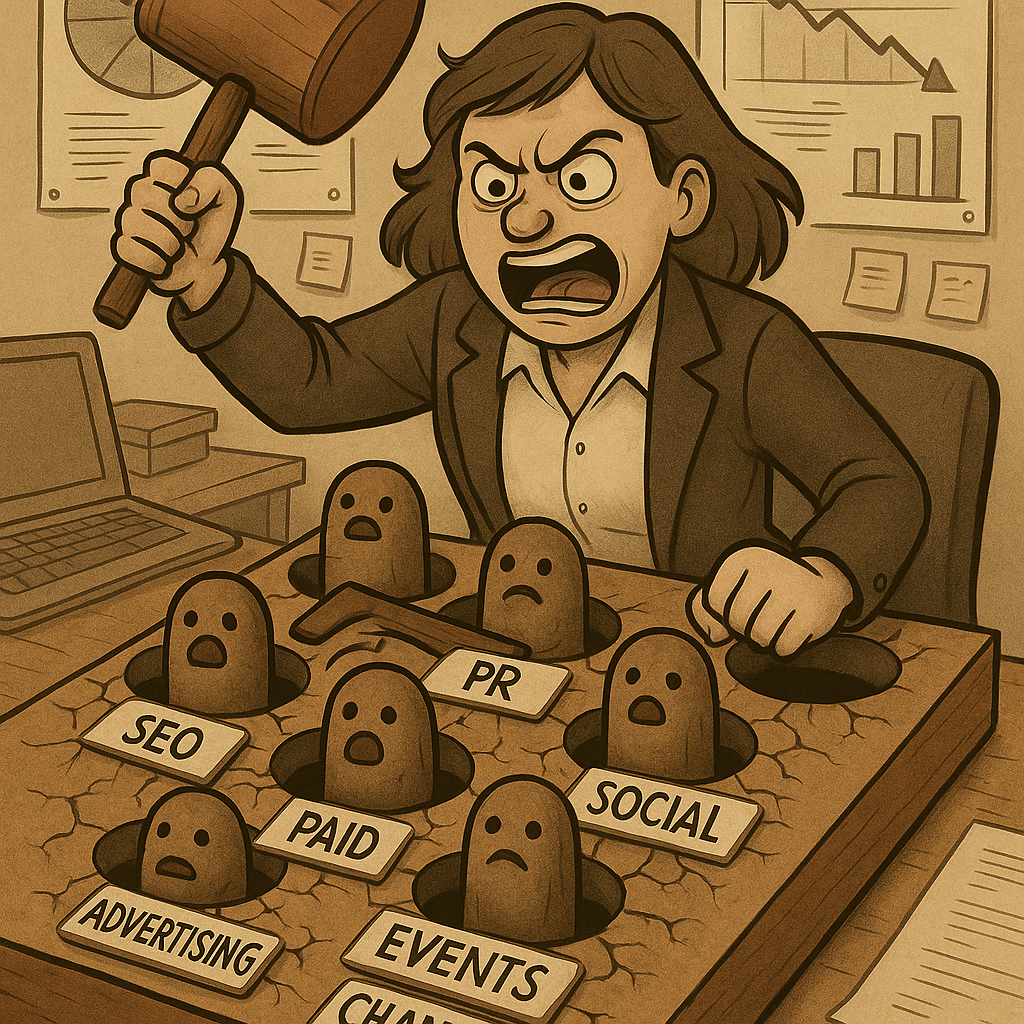Stop Playing Marketing Whack-a-Mole (What To Do Instead)
Marketing’s biggest problem might not be what you think.
Here’s the reality: Most marketing leaders are still unsure of which marketing activities or investments are producing real business results. Instead of building toward a bigger goal, they jump from channel to channel (email, paid ads, social, SEO, ABM), firefighting the latest pain point.
In the meantime, new campaigns and assets get added to the already-overloaded to-do list. The result? A never-ending game of Marketing Whack-a-Mole.

The Cycle We See Too Often
Many teams try to “fix the channel” in isolation:
- Email open rates are down → run a new test.
- Paid campaign ROI looks low → swap creative.
- Social engagement dips → add more posts.
Without a holistic approach, everyone ends up running in circles.
We’ve all seen what happens next:
- Sales says: “Did you see our competitors’ blog and video? We need that, now!”
- Marketing notices: “SEO traffic is down… wait; CRAP! How do we influence AI Overviews in search?”
- Leadership asks: “How are these activities tied to revenue?”
Marketing jumps into action, auditing channels, setting more KPIs, piling more work onto already stretched team members.
Before you know it, the quarter is over.
Marketing scrambles to pull together a highlight deck, cramming in every activity, asset, and request fulfilled.
It’s a flurry of activity meant to prove value… but when you look closely, it’s really just a list of actions taken, not business impact delivered.
Meanwhile, in Sales…
Sales teams have different, but equally frustrating, pain points:
- “We’re still not showing up in the market.”
- “Our value proposition isn’t cutting through.”
- “Only a handful of reps know how to showcase the value.”
Sales requests start piling up—battlecards, videos, case studies, events to attend, sponsorships, and more success stories. Marketing scrambles to deliver, checking off tactical requests, but both teams still end up dissatisfied.
So, What’s the Real Problem?
The real issue isn’t that marketing is failing to hit its KPIs. The problem is misalignment between sales and marketing.
When sales and marketing aren’t truly aligned:
- Marketing gets stuck in reactive mode
- Sales gets frustrated by the lack of “effective” support
- The company misses growth opportunities
Sure, on paper, everyone says they’re aligned. But in reality, marketing often operates as an internal agency, fulfilling requests, while sales pushes for “more stuff,” not always knowing what will actually move the needle.
What NOT to Do
❌ Wrong Answer #1: Keep playing Marketing Whack-a-Mole
You and your team should utilize AI tools and process improvements to optimize your channels’ impact.
❌ Wrong Answer #2: Fulfill every sales request
It’s not about saying “yes” to everything; it’s about creating the right tools for sales to have the right conversations.
❌ Wrong Answer #3: Just “do more”
Without a unified strategy and outcome-based goals, more deliverables fragment the message, drain your resources, and confuse your prospects.
What TO Do: Build a Demand Generation Machine
The right answer is to position marketing as a revenue engine, not a service desk. That means building what we call a Demand Generation Machine.
What Is a Demand Generation Machine?
A demand generation machine is a scalable, repeatable system that unites sales, marketing, and product teams behind one shared goal: revenue growth.
It’s the engine, powered by a clear, data-driven strategy plus the right AI solutions, that helps you:
- Align with product marketing on the right personas, differentiators, and compelling competitive messaging
- Align with sales on the most pressing business problems your prospects are trying to solve
- Align with brand & communications on integrated campaigns that span every channel
- Deliver qualified, high-intent leads that sales is excited to act on
- Demand real-time performance visibility, so every initiative is measured and optimized
- Attribute marketing directly to revenue impact, not just vanity metrics
Outcomes of a Demand Generation Machine
When it’s working, you’ll see:
- Shared Revenue Ownership – Sales and marketing are both accountable for the pipeline and growth
- Fewer Random Acts of Marketing – Every campaign is mapped to a clear, measurable business outcome
- Sustainable Growth – A repeatable, predictable system for fueling demand and closing sales
What’s Next
In our next post, we’ll unpack the blueprint to build a Demand Generation Machine, transforming marketing from a reactive support function into a key driver of growth, earning its seat at the revenue table.
